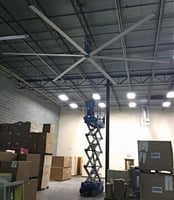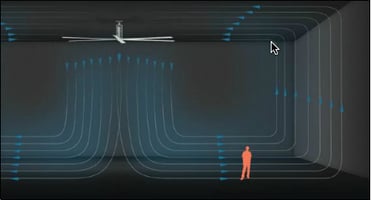How to Keep Condensation off Cement Floors
Condensation can be a huge problem in any facility. Not only can moisture cause damage to inventory and equipment, but it can also lead to serious injury if a staff member slips and falls because of a slick floor. This problem is especially prevalent on concrete and cement floors, which tend to attract moisture because of their temperature.
To solve condensation problems in your facility, you must first identify where they come from.
What Causes Condensation on Cement Floors?
Although moisture can come from processes that create heat or runoff from fluid used in equipment like forklifts and hand trucks, serious condensation is usually caused by the temperature difference between cold cement floors and warm air. When warm air moves over a cement floor that has cooled overnight, the air temperature lowers to match the floor. Since cooler air cannot hold as much moisture, it leaves condensation deposits on the floor. This issue is known as Sweating Slab Syndrome (SSS).
This problem can be seen in a variety of climates across the globe. SSS is a particular pain point for facilities in the southeastern United States. This area has a warm climate and is in close proximity to warm water. That means there is more moisture in the air. Luckily, there is a solution that can help reduce the prevalence of SSS in almost all building types. HVLS fans.

How HVLS Fans Reduce Condensation on Cement Floors
HVLS fans help prevent moisture on cement floors by circulating air more effectively throughout a facility. When air circulation is improved, the temperature of the air is equalized. This means there's less warm air to deposit moisture on cold cement floors. This is a process known as thermal destratification. Thermal destratification breaks up the layers of hot and cold air to create a more even temperature throughout the space.
Besides promoting airflow, there are a few other steps you can take to make sure the temperature of your space is equalized: keep doors and windows closed as often as possible, purchase a dehumidifier for your building, and install a moisture barrier on top of your concrete floors. Some of these options can be expensive, so make sure to consider the costs and relative value of each one. An HVLS fan is a cost-effective option for minimizing moisture on cement floors since they can be run all day for about a dollar.
The Bottom Line
Damp cement floors caused by Sweating Slab Syndrome (SSS) can cause harm to your equipment, your products, and most importantly, your workforce. By equalizing the temperature in your space with an HVLS fan, you can ensure that moisture on your floors becomes less of a problem. This frees you up to focus more on handling the day-to-day functions of your business.


